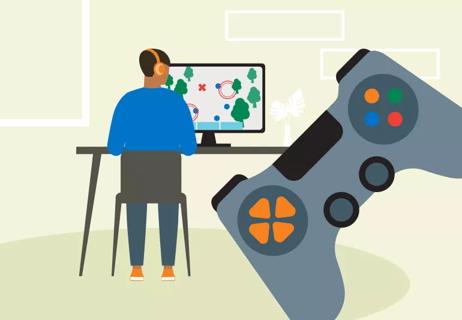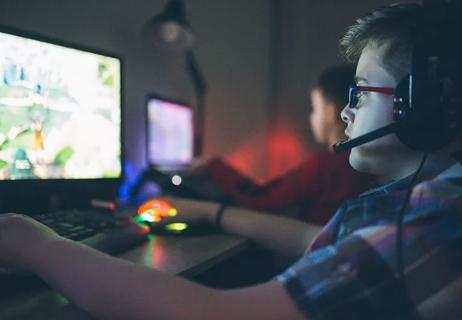YouTube, TikTok, Disney+, Netflix, Nintendo Switch. Despite our best intentions, screen time does tend to creep up when the going gets tough. It’s certainly no shock, right parents?
Advertisement
Cleveland Clinic is a non-profit academic medical center. Advertising on our site helps support our mission. We do not endorse non-Cleveland Clinic products or services. Policy
They’re feeling under the weather. You’ve got a headache. You are trying (desperately!) to work from home. You’re on a conference call and you NEED them to be quiet for 30 minutes. (And, then there’s what your boss told you needs to be done ASAP after. So add another 45 minutes.)
It’s life in the digital age. But pediatric psychologist Kate Eshleman, PsyD, says thinking outside the box is the best way to minimize the amount of time your kids spend staring at their device of choice. Need some inspiration? Here are her top 12 recommendations for disconnecting without hearing the dreaded, “But I’m soooooo bored!”
- Get them outside. It doesn’t matter whether it’s shooting hoops, taking a bike ride, a run, skateboarding, digging in the garden, drawing with chalk or a photo scavenger hunt. Dr. Eshleman says the act of simply getting some fresh air (and burning off some excess energy!) is what’s important.
- Motivate them to help out around the house. Yep! Sound far fetched? It’s all in how you position it. Appeal to younger kids’ pride that they’re “allowed” to sweep (and wash!) the floor, dust or fold laundry. For tweens and teens, broaden that to running a load of towels, making dinner or loading the dishwasher. (Sweeten the deal with task-appropriate payment, if needed.). “This is a perfect opportunity to educate your kids about how your community is working together to address the current coronavirus pandemic, and how we can model this in our homes too,” Dr. Eshleman says.
- Crafty is always cool. Sure, coloring is commonplace. But sometimes messy is what’s needed. Paint, make a collage, cut out paper garlands, create colorful masks. For older kids, there are crafts they won’t find stupid. Encourage them to make embroidery floss friendship bracelets, draw comics, cover their bedroom wall with their favorite photos, make necklaces or earrings, or a DIY lightsaber — or what about glow-in-the-dark JELL-O? “This may also be a great time to make items for those who are hardest hit by ‘social distancing,’ ” Dr. Eshleman says. “So sending cards to those in nursing homes or hospital units may add additional purpose to your kids’ activities.”
- Drag out those collections. (We’re talking theirs AND yours). They have their seashells, shark teeth, action figures and Pokemon cards. But do you still have your 1980s scratch-n-sniff sticker books, stamp collections, crystal and mineral samples, and wheat pennies? “You might be surprised at how fascinated your kids will be by things that once interested you,” Dr. Eshleman says.
- Fort building! Yeah, you won’t be able to walk through the living room, but kids anywhere from 2 to early tweens will find them fun. They can be of the dining room chairs, bed sheets and clips variety. Or the cardboard box variety (before you get rid of that humongous refrigerator or dishwasher box). Just give them some markers, colored duct tape, stickers, you name it! Bonus: Let them eat lunch or dinner there!
- Build anything. Now’s the time to drag out the Legos, Magna-Tiles, model airplanes, constructor sets, and all those things with gears and whatnots. “From towers to mazes to airports to gadgets, you’ll probably be rather impressed with what their minds can come up with,” Dr. Eshleman says.
- Puzzles and board games. Jigsaw puzzles are great for all ages, when piece sizes and counts are appropriate. “And siblings can often entertain each other — but be prepared for mild to moderate competitiveness to bickering — for at least a solid hour,” Dr. Eshleman says. Push beyond the predictable Candyland and Monopoly. Explore games like Bugs in the Kitchen, Enchanted Forest, Doodle Quest and Flashlights & Fireflies.
- Photo albums. Nostalgia reigns, even in the young. So (if your kids pre-date the Instagram and Facebook-only sharing era), reach up on those high closet shelves and bring out their Baby Books and your childhood family photos (but maybe skip those high school prom and college-era ones, eh?)
- Let them eat cake, or cupcakes or cookies. Younger kids love to assist in the kitchen and older ones can scour cookbooks (or use their limited screen time) selecting a recipe or two that strike their fancy. Banana bread? Sugar cookies? “An occasional indulgence is fine, after all, and baking is a great life skill to have,” Dr. Eshleman says.
- Read and write. No, not in the school sense. Use downtime away from the classroom as an opportunity to have them order a title or two from an online bookstore that they can really get lost in. Or ask them to write a letter to a favorite aunt or a grandparent. Or a friend they’re missing. Or get them hooked on journaling.
- Are podcasts cheating? They’re not screen time. So they’re really not any more electronic than, say, radio. “It’s likely you’ve got your favorites for your commute or time at the gym,” Dr. Eshleman says. “But you might not know how many amazing podcasts are out there for kids — or how enthralled they might also get in their stories.”
- Uh, last but not least, play with what they already have. Just saying. There’s a high probability that there are toys or projects in your house that they got for holidays or birthdays or any days that they either haven’t used yet, or haven’t dusted off in a while (hence, like brand new, or an old friend!). “Having extra time at home is the perfect time for an un-preachy lesson about being deliberate with our time and being thankful for what — and who — we have in our lives.”
At the end of the day, unless you have kids under 18 months (who should have no screen time, according to the American Academy of Pediatrics), it’s likely that a break from school will include some sort of media consumption, Dr. Eshleman says.
But your goal is to keep them from staying glued to their devices and follow age-appropriate screen time limits. That way, you’ll ensure their interest in a wide variety of activities — avoiding meltdowns when it’s time to return to regular school schedules.
“And remember, healthy limits also start with providing a good example for your kids,” Dr. Eshleman says. “Even if you’re working from home and on your laptop, maybe even more than you’d like, make sure you have tech-free downtime as a family. That can be dinnertime, story time or just time to catch up on what’s going on in each other’s lives.”







